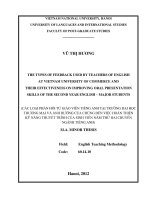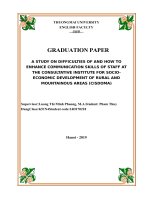Oral communication skills
Bạn đang xem bản rút gọn của tài liệu. Xem và tải ngay bản đầy đủ của tài liệu tại đây (10.46 MB, 56 trang )
Presentation
and
Oral Communication Skills
Sandhya Dwarkadas, University of Rochester
Susan Rodger, Duke University
Welcome
Always greet your audience and tell
them you are honored to talk to them!
Introduction
Susan H. Rodger, Professor of the Practice, Duke University
The Technical Me
PhD Computer Science, Purdue University
BS Math and CS, North Carolina State University
Research: Visualization, algorithm animation, software for
learning computer, computer science education
Service: SIGCSE Board Chair, CRA-W Board
OutReach: Adventures in Alice Programming for K-12
teachers
One minute exercise
On a scale of 1 to 10,
how confident do you feel right now?
Please stand and put your
hands on your hips
One minute exercise
On a scale of 1 to 10,
how confident do you feel right now?
Learn from
the best
Who inspires you and why?
Ted Talks Amy Cuddy
“Your body language
shapes who you are”
Sandhya Dwarkadas
• Education
• Bachelor’s degree in Electronics from Indian Institute
of Technology, Madras, India
• Master’s and Ph.D. in Electrical and Computer
Engineering from Rice University, Houston, Texas
• Research Area: Computer systems: architecture, parallel
and distributed systems
• Post-Ph.D.
• Research scientist at Rice for 4 years
• Faculty member at University of Rochester since
• Currently the Albert Arendt Hopeman
Professor and Chair of Computer Science with a
secondary appointment in Electrical and
Computer Engineering
• Sabbaticals at IBM Watson, HPCLinks/IISc India, EPFL
Switzerland
The image part with relationship ID rId2 was not found in the file.
Why do Presentations Skills
Matter?
Essential for
• Crystallizing your ideas
• disseminating important results
• Ideas don’t sell themselves; they will lie on
the shelf and gather dust unless you sell them
• Explaining your work to colleagues
• Giving talks/seminars in industry or academia
• Selling your ideas to funding agencies (or venture
capital firms)
• Interviewing for jobs
Oral Presentation:
The Three MUST HAVES
• Content: know your material really well
• Design: Organize the material and create a
high-quality presentation (usually, for formal
research talks, in the form of slides)
• Drive home key points
• Visualize what you are saying
• Delivery: plan your oral presentation/what
you will say along with each slide
• practice, practice, practice
Content: Know Your Material
• Do you have sufficient motivation for the work?
• What is the state of the art?
• What is your contribution/approach? How is it
novel?
• Is the work mature enough for
presentation/have you ironed out the corner
cases?
• How sound are your results and analysis?
• Remember: you are the expert (have chosen to
become one): now you need to project that
image
Design: Organize Your Material
• What are the key points you want your
audience to remember?
• Keep it simple
• Repeat them: tell them what you’re going to tell
them (forecast) and why, tell them, and tell them
what you told them (summary)
• Is your presentation at an appropriate level
for your audience?
• Start with the outline
Delivery
PRACTICE, PRACTICE,
PRACTICE!
Build your confidence; get feedback; form a
support group; return the favor
URCS
Know Your Audience and
Purpose
• Who is your audience? Why are they there?
What do they know? What biases do they
have?
• What is the purpose of your talk?
• To inform? To persuade? To inspire? To teach?
• Is this a formal or informal occasion? What is
the size of your audience? How much time do
you have?
Conference Talks
Remember
• There is no way you will cover every detail of a 10
page paper in 25 minutes
• The main goal is to get the audience interested in
your work so they go read the paper
• The talk is that sales job (but don’t overdo the
selling)
How to Give a Bad Talk: The Ten
(9) Commandments*
•
•
•
•
•
•
•
•
•
Thou shalt not waste space
Thou shalt not be neat
Thou shalt not covet brevity
Thou shalt not write large
Thou shalt not use color
Thou shalt not illustrate
Thou shalt not make eye contact
Thou shalt not skip slides in a long talk
Thou shalt not practice
*Courtesy David Patterson, circa 1983, via Mark Hill, with appropriate
modification to accommodate changes in technology
Thou Shalt Not Covet Brevity
Slide Design
• 3 is the golden number (almost!); 3-5 bullets
or points per slide
• Don’t overcrowd
• Make sure font is legible even in your figures
(test it out in a room of similar size)
• Spell and grammar check!
• No need for complete sentences, but be
consistent in your style and format
A General Talk Outline
(25 mins.)
Title/author/affiliation (1 slide)
Motivation and problem statement (1-3 slides)
Related work (0-1 slides)
Main ideas and methods (7-8 slides)
Analysis of results and key insights (3-4 slides)
Summary (1 slide)
Future work (0-1 slide)
Motivation
and
Problem Statement
Outline Slide or No Outline
Slide:
To be or not to be
URCS
Roadmap
Background
Design
Evaluation
Conclusion
Roadmap
Background
Design
Evaluation
Conclusion
Background:
Brief Introduction of Page Coloring
Background:
Brief Introduction of Page Coloring









